Ethical Decision Making Framework in Nursing: A Case Study Analysis
VerifiedAdded on 2023/01/18
|11
|2842
|42
Report
AI Summary
This report delves into the ethical decision-making model within nursing, utilizing a case study involving a patient with myocardial infarction and prostate cancer complications. It evaluates the nurse's actions, considering factors influencing decision-making, including legislative acts like the Health Practitioner Regulation National Law (WA) Act 2010, ethical conduct, and registered nursing standards. The analysis incorporates ethical principles such as utilitarianism, rights, fairness, common good, and virtue, alongside the integrated decision-making model. The report examines the complexities of end-of-life care, the importance of consulting with medical professionals and family members, and the application of the ethical decision-making framework to determine the most favorable outcome for the patient while adhering to relevant Australian standards and codes of conduct. The conclusion emphasizes the significance of ethical purity, patient support, and the prioritization of the patient's well-being in critical situations.
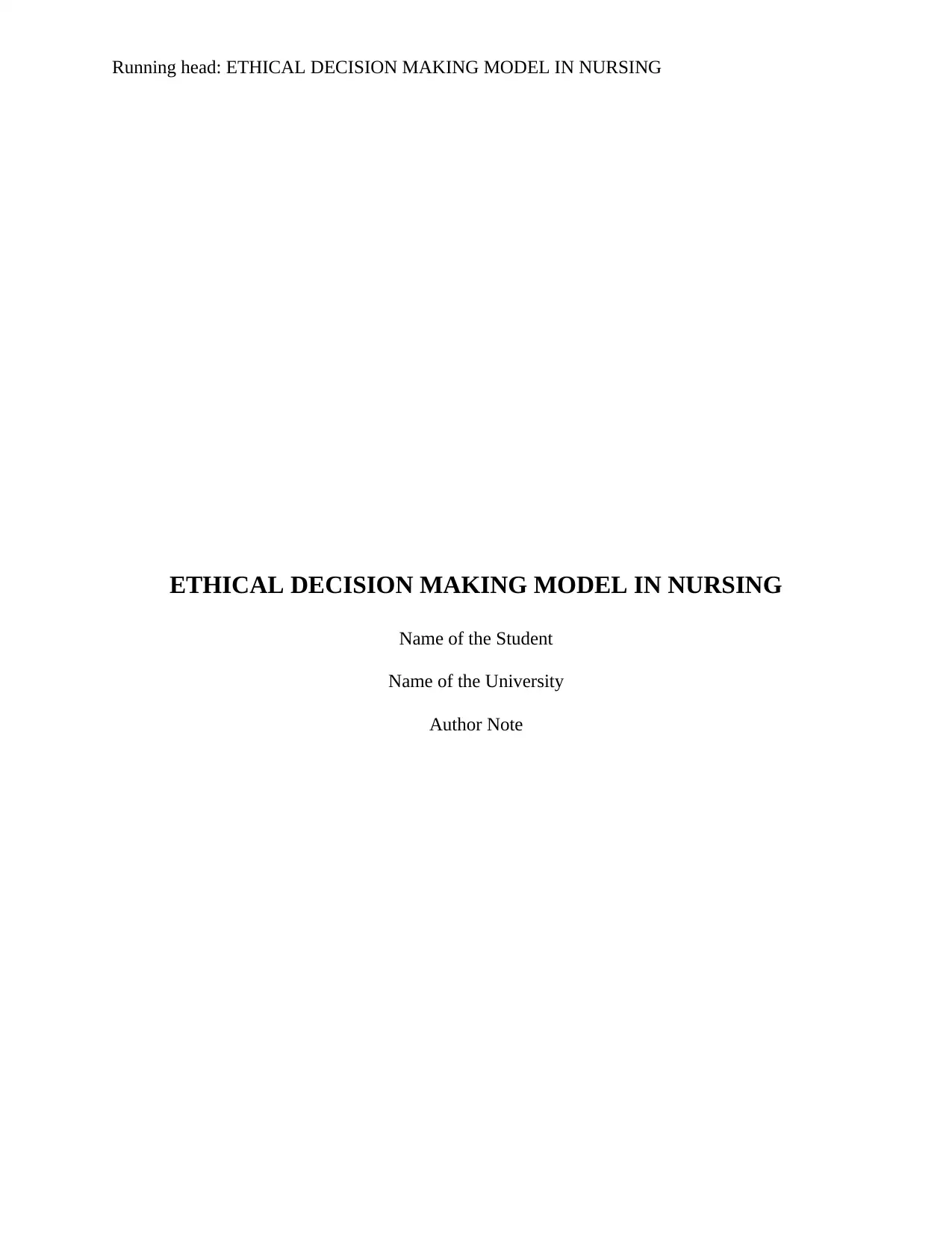
Running head: ETHICAL DECISION MAKING MODEL IN NURSING
ETHICAL DECISION MAKING MODEL IN NURSING
Name of the Student
Name of the University
Author Note
ETHICAL DECISION MAKING MODEL IN NURSING
Name of the Student
Name of the University
Author Note
Paraphrase This Document
Need a fresh take? Get an instant paraphrase of this document with our AI Paraphraser
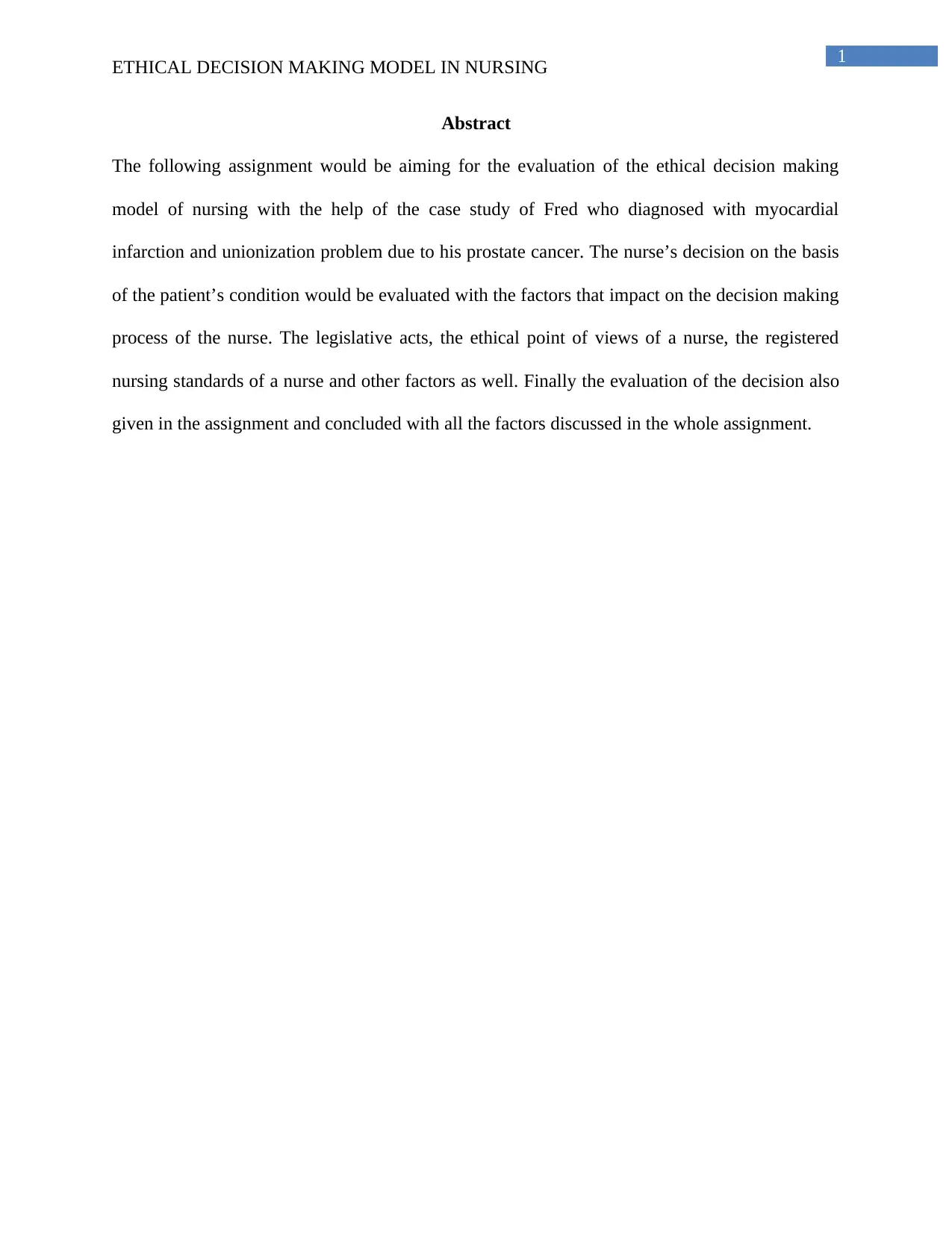
1
ETHICAL DECISION MAKING MODEL IN NURSING
Abstract
The following assignment would be aiming for the evaluation of the ethical decision making
model of nursing with the help of the case study of Fred who diagnosed with myocardial
infarction and unionization problem due to his prostate cancer. The nurse’s decision on the basis
of the patient’s condition would be evaluated with the factors that impact on the decision making
process of the nurse. The legislative acts, the ethical point of views of a nurse, the registered
nursing standards of a nurse and other factors as well. Finally the evaluation of the decision also
given in the assignment and concluded with all the factors discussed in the whole assignment.
ETHICAL DECISION MAKING MODEL IN NURSING
Abstract
The following assignment would be aiming for the evaluation of the ethical decision making
model of nursing with the help of the case study of Fred who diagnosed with myocardial
infarction and unionization problem due to his prostate cancer. The nurse’s decision on the basis
of the patient’s condition would be evaluated with the factors that impact on the decision making
process of the nurse. The legislative acts, the ethical point of views of a nurse, the registered
nursing standards of a nurse and other factors as well. Finally the evaluation of the decision also
given in the assignment and concluded with all the factors discussed in the whole assignment.
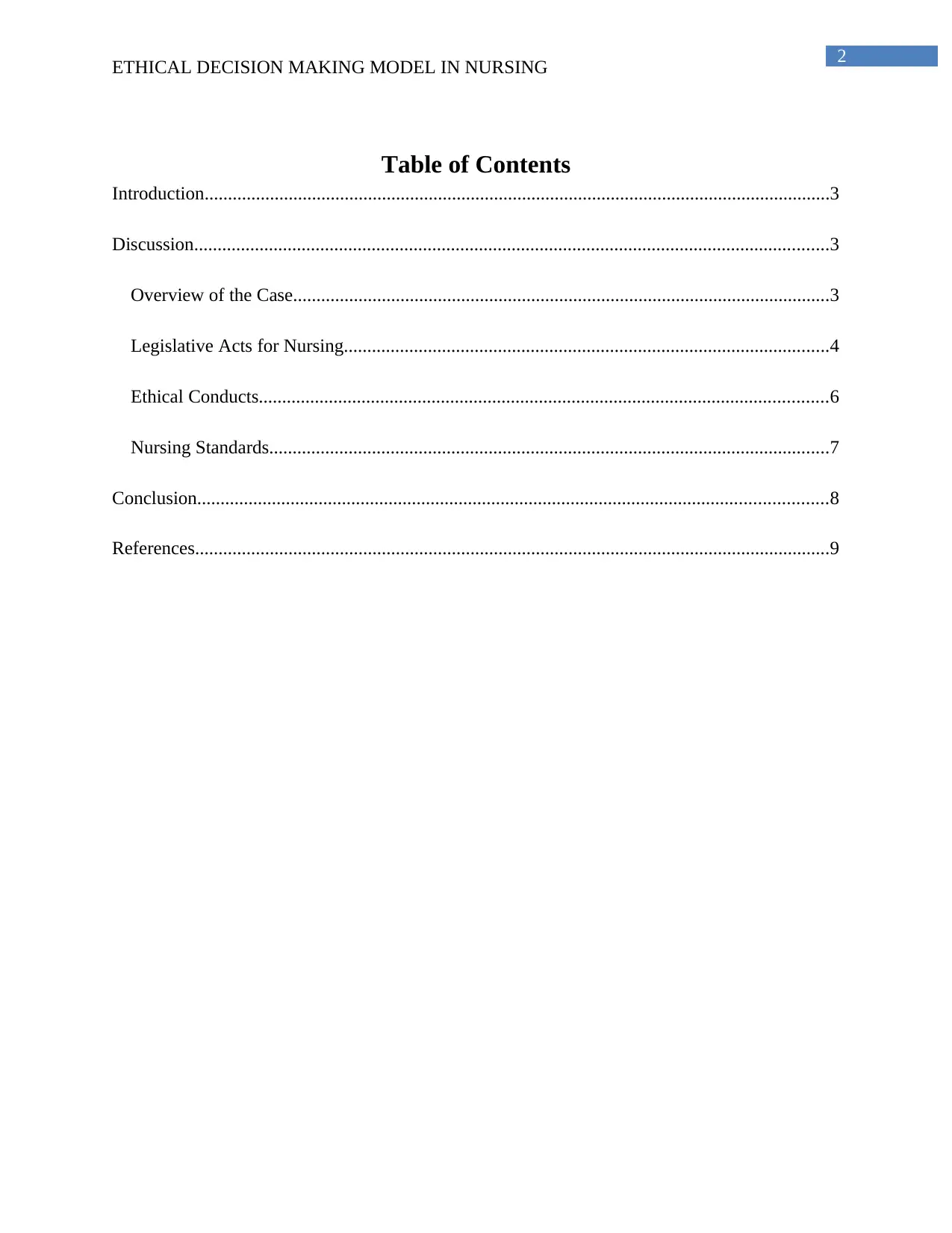
2
ETHICAL DECISION MAKING MODEL IN NURSING
Table of Contents
Introduction......................................................................................................................................3
Discussion........................................................................................................................................3
Overview of the Case...................................................................................................................3
Legislative Acts for Nursing........................................................................................................4
Ethical Conducts..........................................................................................................................6
Nursing Standards........................................................................................................................7
Conclusion.......................................................................................................................................8
References........................................................................................................................................9
ETHICAL DECISION MAKING MODEL IN NURSING
Table of Contents
Introduction......................................................................................................................................3
Discussion........................................................................................................................................3
Overview of the Case...................................................................................................................3
Legislative Acts for Nursing........................................................................................................4
Ethical Conducts..........................................................................................................................6
Nursing Standards........................................................................................................................7
Conclusion.......................................................................................................................................8
References........................................................................................................................................9
⊘ This is a preview!⊘
Do you want full access?
Subscribe today to unlock all pages.

Trusted by 1+ million students worldwide
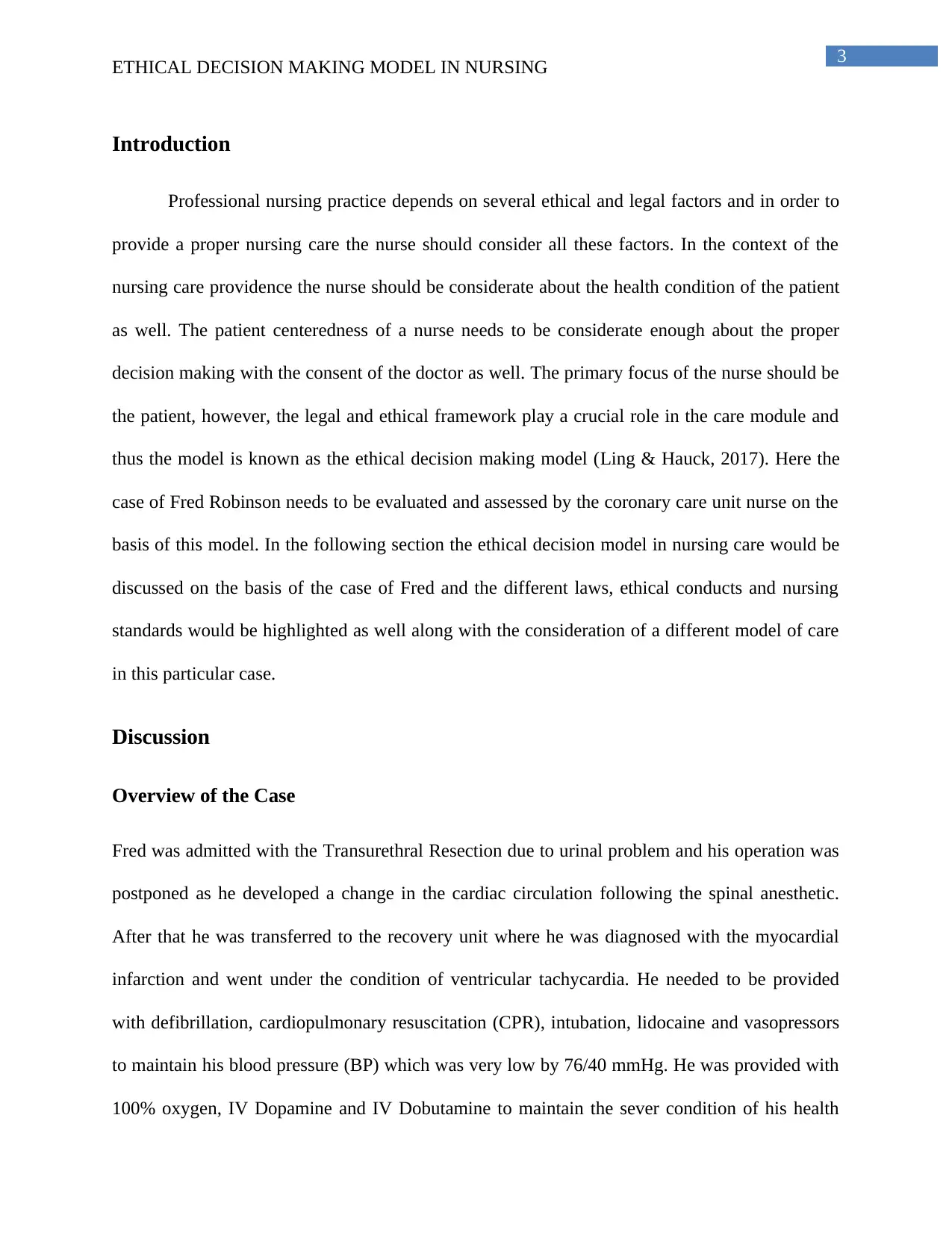
3
ETHICAL DECISION MAKING MODEL IN NURSING
Introduction
Professional nursing practice depends on several ethical and legal factors and in order to
provide a proper nursing care the nurse should consider all these factors. In the context of the
nursing care providence the nurse should be considerate about the health condition of the patient
as well. The patient centeredness of a nurse needs to be considerate enough about the proper
decision making with the consent of the doctor as well. The primary focus of the nurse should be
the patient, however, the legal and ethical framework play a crucial role in the care module and
thus the model is known as the ethical decision making model (Ling & Hauck, 2017). Here the
case of Fred Robinson needs to be evaluated and assessed by the coronary care unit nurse on the
basis of this model. In the following section the ethical decision model in nursing care would be
discussed on the basis of the case of Fred and the different laws, ethical conducts and nursing
standards would be highlighted as well along with the consideration of a different model of care
in this particular case.
Discussion
Overview of the Case
Fred was admitted with the Transurethral Resection due to urinal problem and his operation was
postponed as he developed a change in the cardiac circulation following the spinal anesthetic.
After that he was transferred to the recovery unit where he was diagnosed with the myocardial
infarction and went under the condition of ventricular tachycardia. He needed to be provided
with defibrillation, cardiopulmonary resuscitation (CPR), intubation, lidocaine and vasopressors
to maintain his blood pressure (BP) which was very low by 76/40 mmHg. He was provided with
100% oxygen, IV Dopamine and IV Dobutamine to maintain the sever condition of his health
ETHICAL DECISION MAKING MODEL IN NURSING
Introduction
Professional nursing practice depends on several ethical and legal factors and in order to
provide a proper nursing care the nurse should consider all these factors. In the context of the
nursing care providence the nurse should be considerate about the health condition of the patient
as well. The patient centeredness of a nurse needs to be considerate enough about the proper
decision making with the consent of the doctor as well. The primary focus of the nurse should be
the patient, however, the legal and ethical framework play a crucial role in the care module and
thus the model is known as the ethical decision making model (Ling & Hauck, 2017). Here the
case of Fred Robinson needs to be evaluated and assessed by the coronary care unit nurse on the
basis of this model. In the following section the ethical decision model in nursing care would be
discussed on the basis of the case of Fred and the different laws, ethical conducts and nursing
standards would be highlighted as well along with the consideration of a different model of care
in this particular case.
Discussion
Overview of the Case
Fred was admitted with the Transurethral Resection due to urinal problem and his operation was
postponed as he developed a change in the cardiac circulation following the spinal anesthetic.
After that he was transferred to the recovery unit where he was diagnosed with the myocardial
infarction and went under the condition of ventricular tachycardia. He needed to be provided
with defibrillation, cardiopulmonary resuscitation (CPR), intubation, lidocaine and vasopressors
to maintain his blood pressure (BP) which was very low by 76/40 mmHg. He was provided with
100% oxygen, IV Dopamine and IV Dobutamine to maintain the sever condition of his health
Paraphrase This Document
Need a fresh take? Get an instant paraphrase of this document with our AI Paraphraser
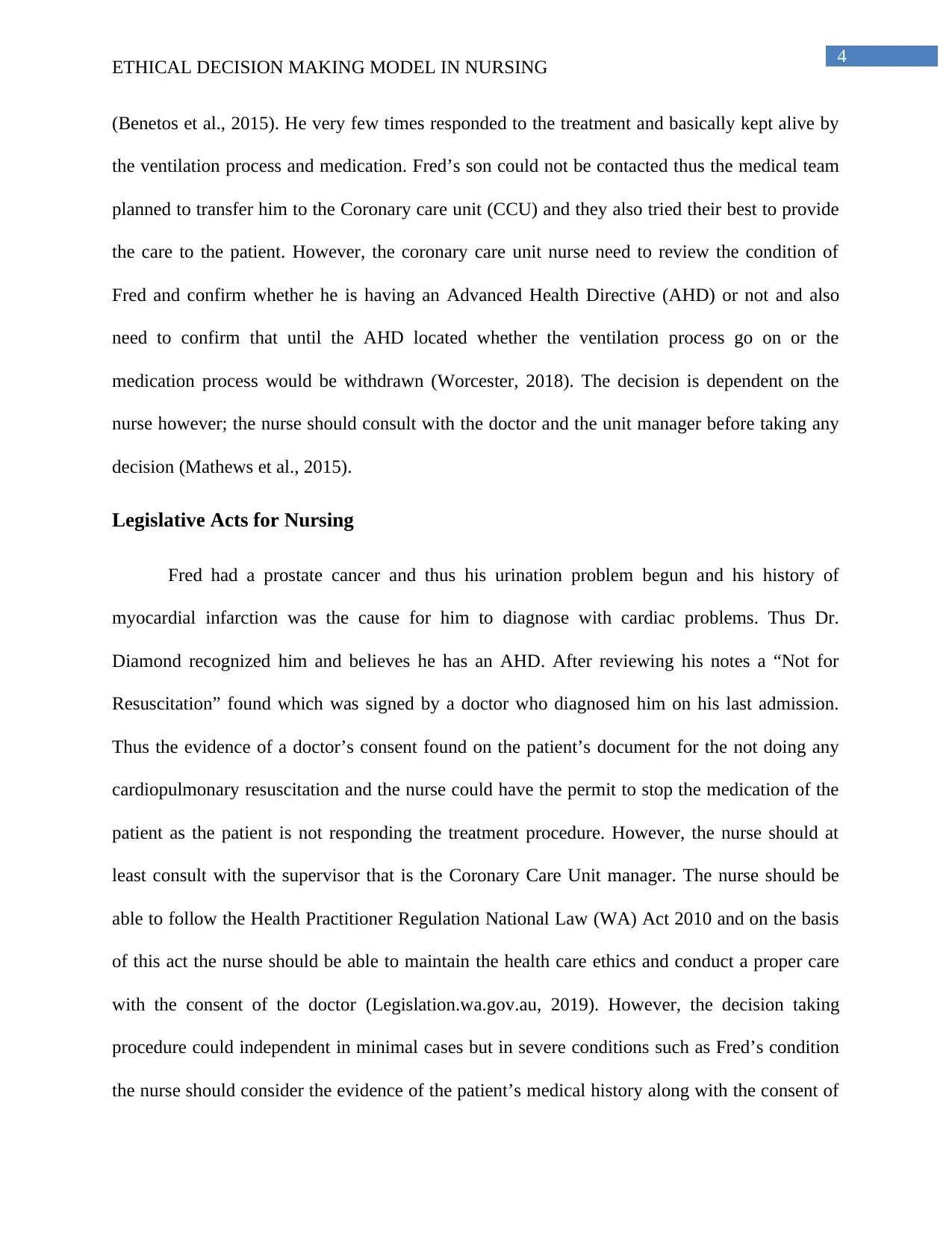
4
ETHICAL DECISION MAKING MODEL IN NURSING
(Benetos et al., 2015). He very few times responded to the treatment and basically kept alive by
the ventilation process and medication. Fred’s son could not be contacted thus the medical team
planned to transfer him to the Coronary care unit (CCU) and they also tried their best to provide
the care to the patient. However, the coronary care unit nurse need to review the condition of
Fred and confirm whether he is having an Advanced Health Directive (AHD) or not and also
need to confirm that until the AHD located whether the ventilation process go on or the
medication process would be withdrawn (Worcester, 2018). The decision is dependent on the
nurse however; the nurse should consult with the doctor and the unit manager before taking any
decision (Mathews et al., 2015).
Legislative Acts for Nursing
Fred had a prostate cancer and thus his urination problem begun and his history of
myocardial infarction was the cause for him to diagnose with cardiac problems. Thus Dr.
Diamond recognized him and believes he has an AHD. After reviewing his notes a “Not for
Resuscitation” found which was signed by a doctor who diagnosed him on his last admission.
Thus the evidence of a doctor’s consent found on the patient’s document for the not doing any
cardiopulmonary resuscitation and the nurse could have the permit to stop the medication of the
patient as the patient is not responding the treatment procedure. However, the nurse should at
least consult with the supervisor that is the Coronary Care Unit manager. The nurse should be
able to follow the Health Practitioner Regulation National Law (WA) Act 2010 and on the basis
of this act the nurse should be able to maintain the health care ethics and conduct a proper care
with the consent of the doctor (Legislation.wa.gov.au, 2019). However, the decision taking
procedure could independent in minimal cases but in severe conditions such as Fred’s condition
the nurse should consider the evidence of the patient’s medical history along with the consent of
ETHICAL DECISION MAKING MODEL IN NURSING
(Benetos et al., 2015). He very few times responded to the treatment and basically kept alive by
the ventilation process and medication. Fred’s son could not be contacted thus the medical team
planned to transfer him to the Coronary care unit (CCU) and they also tried their best to provide
the care to the patient. However, the coronary care unit nurse need to review the condition of
Fred and confirm whether he is having an Advanced Health Directive (AHD) or not and also
need to confirm that until the AHD located whether the ventilation process go on or the
medication process would be withdrawn (Worcester, 2018). The decision is dependent on the
nurse however; the nurse should consult with the doctor and the unit manager before taking any
decision (Mathews et al., 2015).
Legislative Acts for Nursing
Fred had a prostate cancer and thus his urination problem begun and his history of
myocardial infarction was the cause for him to diagnose with cardiac problems. Thus Dr.
Diamond recognized him and believes he has an AHD. After reviewing his notes a “Not for
Resuscitation” found which was signed by a doctor who diagnosed him on his last admission.
Thus the evidence of a doctor’s consent found on the patient’s document for the not doing any
cardiopulmonary resuscitation and the nurse could have the permit to stop the medication of the
patient as the patient is not responding the treatment procedure. However, the nurse should at
least consult with the supervisor that is the Coronary Care Unit manager. The nurse should be
able to follow the Health Practitioner Regulation National Law (WA) Act 2010 and on the basis
of this act the nurse should be able to maintain the health care ethics and conduct a proper care
with the consent of the doctor (Legislation.wa.gov.au, 2019). However, the decision taking
procedure could independent in minimal cases but in severe conditions such as Fred’s condition
the nurse should consider the evidence of the patient’s medical history along with the consent of
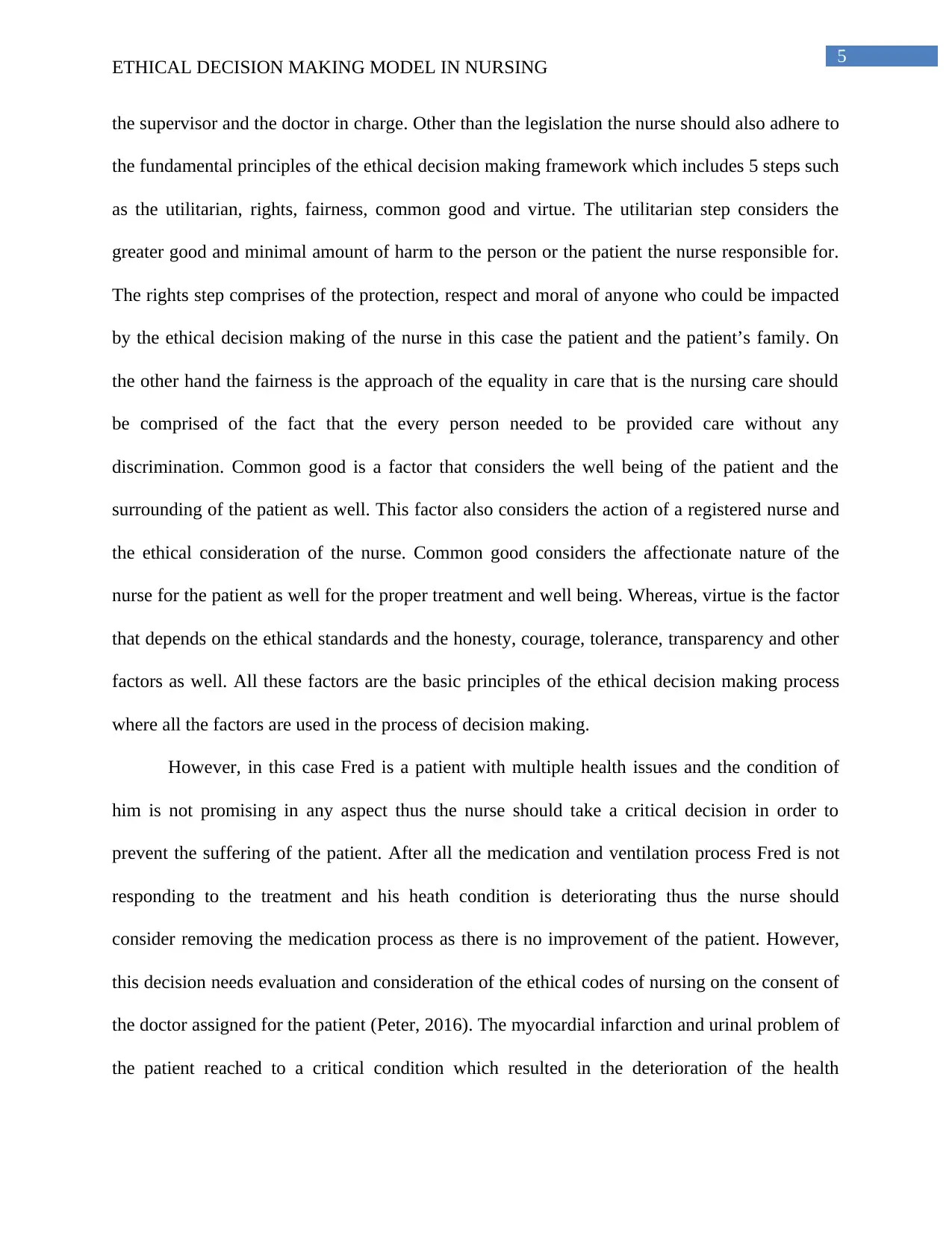
5
ETHICAL DECISION MAKING MODEL IN NURSING
the supervisor and the doctor in charge. Other than the legislation the nurse should also adhere to
the fundamental principles of the ethical decision making framework which includes 5 steps such
as the utilitarian, rights, fairness, common good and virtue. The utilitarian step considers the
greater good and minimal amount of harm to the person or the patient the nurse responsible for.
The rights step comprises of the protection, respect and moral of anyone who could be impacted
by the ethical decision making of the nurse in this case the patient and the patient’s family. On
the other hand the fairness is the approach of the equality in care that is the nursing care should
be comprised of the fact that the every person needed to be provided care without any
discrimination. Common good is a factor that considers the well being of the patient and the
surrounding of the patient as well. This factor also considers the action of a registered nurse and
the ethical consideration of the nurse. Common good considers the affectionate nature of the
nurse for the patient as well for the proper treatment and well being. Whereas, virtue is the factor
that depends on the ethical standards and the honesty, courage, tolerance, transparency and other
factors as well. All these factors are the basic principles of the ethical decision making process
where all the factors are used in the process of decision making.
However, in this case Fred is a patient with multiple health issues and the condition of
him is not promising in any aspect thus the nurse should take a critical decision in order to
prevent the suffering of the patient. After all the medication and ventilation process Fred is not
responding to the treatment and his heath condition is deteriorating thus the nurse should
consider removing the medication process as there is no improvement of the patient. However,
this decision needs evaluation and consideration of the ethical codes of nursing on the consent of
the doctor assigned for the patient (Peter, 2016). The myocardial infarction and urinal problem of
the patient reached to a critical condition which resulted in the deterioration of the health
ETHICAL DECISION MAKING MODEL IN NURSING
the supervisor and the doctor in charge. Other than the legislation the nurse should also adhere to
the fundamental principles of the ethical decision making framework which includes 5 steps such
as the utilitarian, rights, fairness, common good and virtue. The utilitarian step considers the
greater good and minimal amount of harm to the person or the patient the nurse responsible for.
The rights step comprises of the protection, respect and moral of anyone who could be impacted
by the ethical decision making of the nurse in this case the patient and the patient’s family. On
the other hand the fairness is the approach of the equality in care that is the nursing care should
be comprised of the fact that the every person needed to be provided care without any
discrimination. Common good is a factor that considers the well being of the patient and the
surrounding of the patient as well. This factor also considers the action of a registered nurse and
the ethical consideration of the nurse. Common good considers the affectionate nature of the
nurse for the patient as well for the proper treatment and well being. Whereas, virtue is the factor
that depends on the ethical standards and the honesty, courage, tolerance, transparency and other
factors as well. All these factors are the basic principles of the ethical decision making process
where all the factors are used in the process of decision making.
However, in this case Fred is a patient with multiple health issues and the condition of
him is not promising in any aspect thus the nurse should take a critical decision in order to
prevent the suffering of the patient. After all the medication and ventilation process Fred is not
responding to the treatment and his heath condition is deteriorating thus the nurse should
consider removing the medication process as there is no improvement of the patient. However,
this decision needs evaluation and consideration of the ethical codes of nursing on the consent of
the doctor assigned for the patient (Peter, 2016). The myocardial infarction and urinal problem of
the patient reached to a critical condition which resulted in the deterioration of the health
⊘ This is a preview!⊘
Do you want full access?
Subscribe today to unlock all pages.

Trusted by 1+ million students worldwide
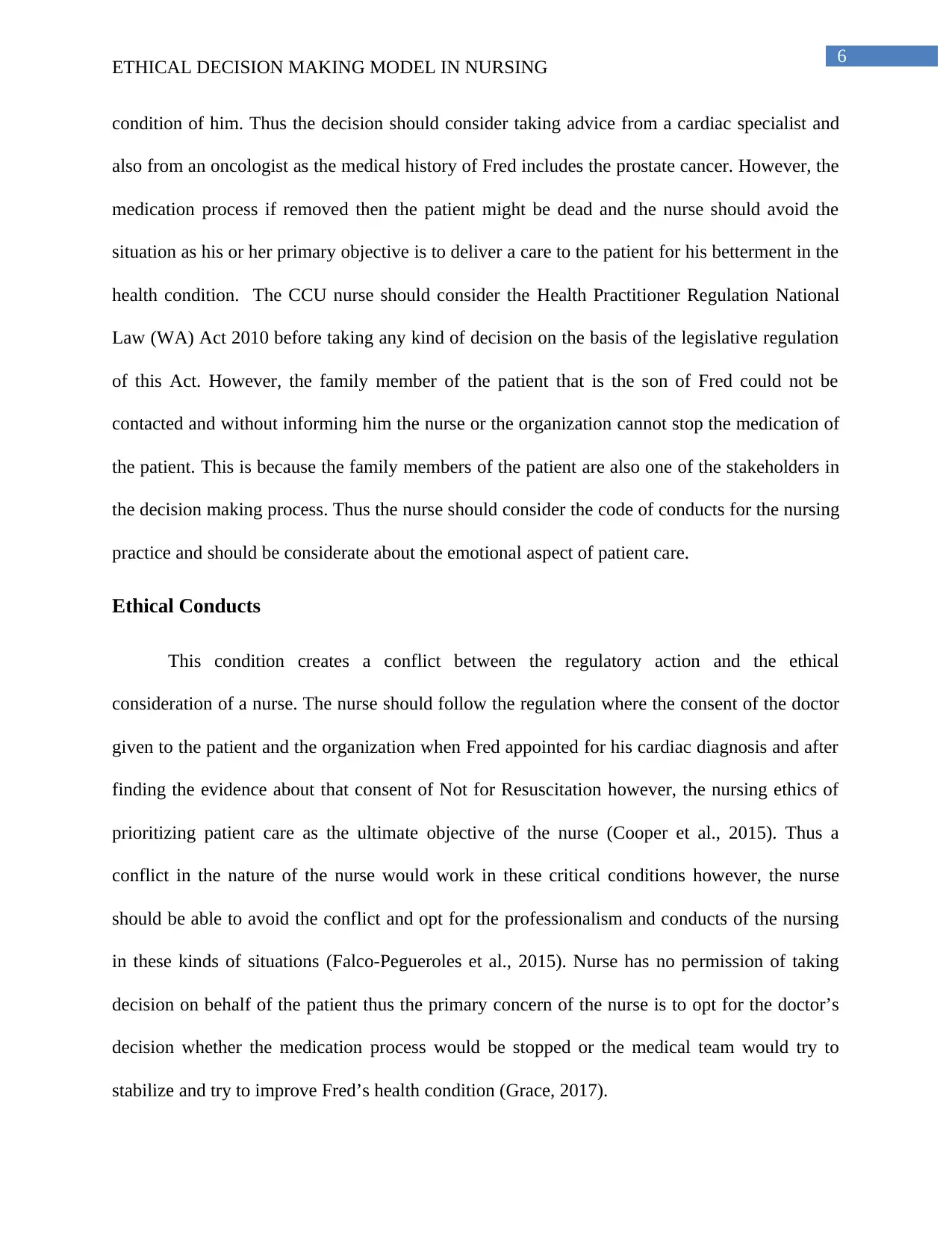
6
ETHICAL DECISION MAKING MODEL IN NURSING
condition of him. Thus the decision should consider taking advice from a cardiac specialist and
also from an oncologist as the medical history of Fred includes the prostate cancer. However, the
medication process if removed then the patient might be dead and the nurse should avoid the
situation as his or her primary objective is to deliver a care to the patient for his betterment in the
health condition. The CCU nurse should consider the Health Practitioner Regulation National
Law (WA) Act 2010 before taking any kind of decision on the basis of the legislative regulation
of this Act. However, the family member of the patient that is the son of Fred could not be
contacted and without informing him the nurse or the organization cannot stop the medication of
the patient. This is because the family members of the patient are also one of the stakeholders in
the decision making process. Thus the nurse should consider the code of conducts for the nursing
practice and should be considerate about the emotional aspect of patient care.
Ethical Conducts
This condition creates a conflict between the regulatory action and the ethical
consideration of a nurse. The nurse should follow the regulation where the consent of the doctor
given to the patient and the organization when Fred appointed for his cardiac diagnosis and after
finding the evidence about that consent of Not for Resuscitation however, the nursing ethics of
prioritizing patient care as the ultimate objective of the nurse (Cooper et al., 2015). Thus a
conflict in the nature of the nurse would work in these critical conditions however, the nurse
should be able to avoid the conflict and opt for the professionalism and conducts of the nursing
in these kinds of situations (Falco-Pegueroles et al., 2015). Nurse has no permission of taking
decision on behalf of the patient thus the primary concern of the nurse is to opt for the doctor’s
decision whether the medication process would be stopped or the medical team would try to
stabilize and try to improve Fred’s health condition (Grace, 2017).
ETHICAL DECISION MAKING MODEL IN NURSING
condition of him. Thus the decision should consider taking advice from a cardiac specialist and
also from an oncologist as the medical history of Fred includes the prostate cancer. However, the
medication process if removed then the patient might be dead and the nurse should avoid the
situation as his or her primary objective is to deliver a care to the patient for his betterment in the
health condition. The CCU nurse should consider the Health Practitioner Regulation National
Law (WA) Act 2010 before taking any kind of decision on the basis of the legislative regulation
of this Act. However, the family member of the patient that is the son of Fred could not be
contacted and without informing him the nurse or the organization cannot stop the medication of
the patient. This is because the family members of the patient are also one of the stakeholders in
the decision making process. Thus the nurse should consider the code of conducts for the nursing
practice and should be considerate about the emotional aspect of patient care.
Ethical Conducts
This condition creates a conflict between the regulatory action and the ethical
consideration of a nurse. The nurse should follow the regulation where the consent of the doctor
given to the patient and the organization when Fred appointed for his cardiac diagnosis and after
finding the evidence about that consent of Not for Resuscitation however, the nursing ethics of
prioritizing patient care as the ultimate objective of the nurse (Cooper et al., 2015). Thus a
conflict in the nature of the nurse would work in these critical conditions however, the nurse
should be able to avoid the conflict and opt for the professionalism and conducts of the nursing
in these kinds of situations (Falco-Pegueroles et al., 2015). Nurse has no permission of taking
decision on behalf of the patient thus the primary concern of the nurse is to opt for the doctor’s
decision whether the medication process would be stopped or the medical team would try to
stabilize and try to improve Fred’s health condition (Grace, 2017).
Paraphrase This Document
Need a fresh take? Get an instant paraphrase of this document with our AI Paraphraser
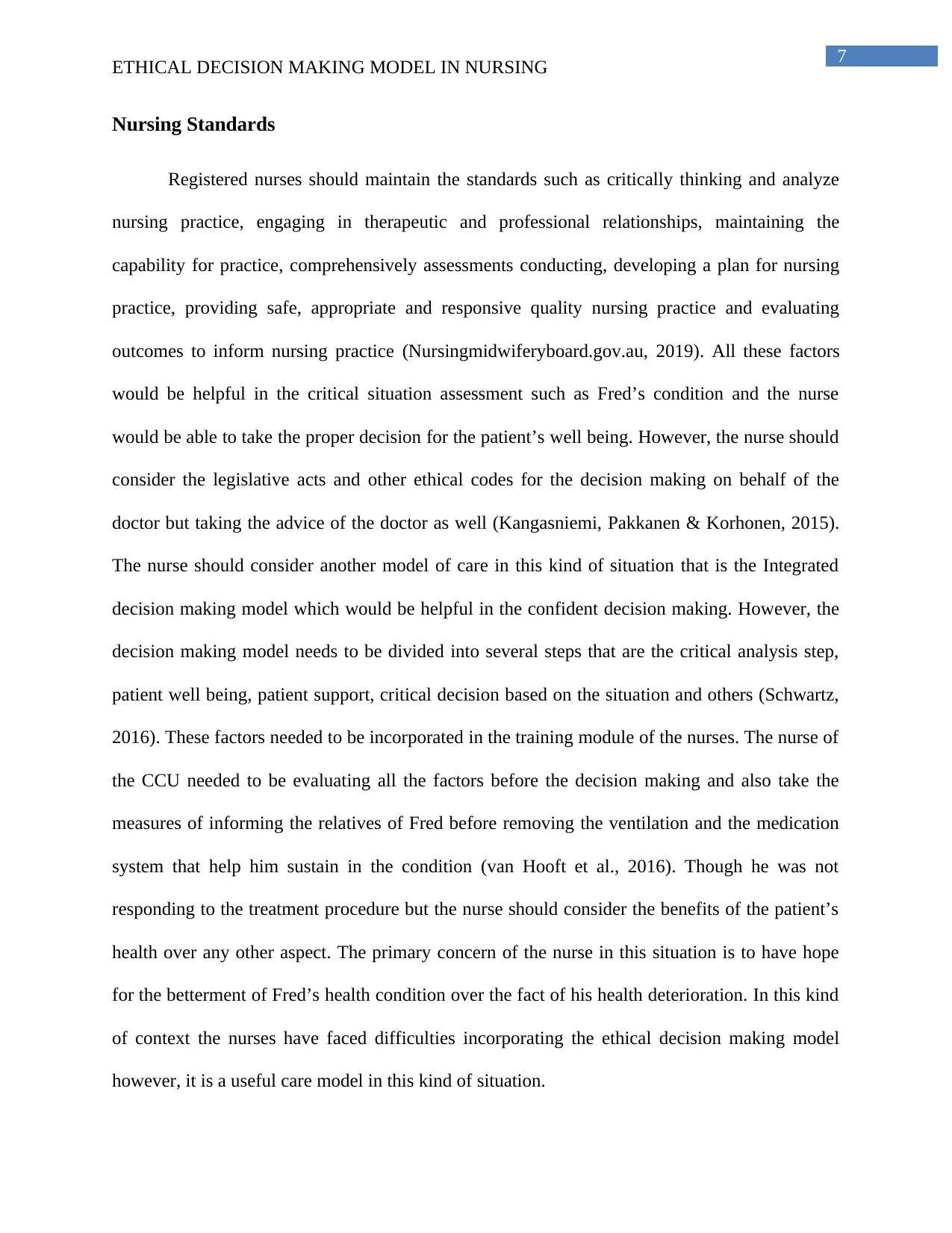
7
ETHICAL DECISION MAKING MODEL IN NURSING
Nursing Standards
Registered nurses should maintain the standards such as critically thinking and analyze
nursing practice, engaging in therapeutic and professional relationships, maintaining the
capability for practice, comprehensively assessments conducting, developing a plan for nursing
practice, providing safe, appropriate and responsive quality nursing practice and evaluating
outcomes to inform nursing practice (Nursingmidwiferyboard.gov.au, 2019). All these factors
would be helpful in the critical situation assessment such as Fred’s condition and the nurse
would be able to take the proper decision for the patient’s well being. However, the nurse should
consider the legislative acts and other ethical codes for the decision making on behalf of the
doctor but taking the advice of the doctor as well (Kangasniemi, Pakkanen & Korhonen, 2015).
The nurse should consider another model of care in this kind of situation that is the Integrated
decision making model which would be helpful in the confident decision making. However, the
decision making model needs to be divided into several steps that are the critical analysis step,
patient well being, patient support, critical decision based on the situation and others (Schwartz,
2016). These factors needed to be incorporated in the training module of the nurses. The nurse of
the CCU needed to be evaluating all the factors before the decision making and also take the
measures of informing the relatives of Fred before removing the ventilation and the medication
system that help him sustain in the condition (van Hooft et al., 2016). Though he was not
responding to the treatment procedure but the nurse should consider the benefits of the patient’s
health over any other aspect. The primary concern of the nurse in this situation is to have hope
for the betterment of Fred’s health condition over the fact of his health deterioration. In this kind
of context the nurses have faced difficulties incorporating the ethical decision making model
however, it is a useful care model in this kind of situation.
ETHICAL DECISION MAKING MODEL IN NURSING
Nursing Standards
Registered nurses should maintain the standards such as critically thinking and analyze
nursing practice, engaging in therapeutic and professional relationships, maintaining the
capability for practice, comprehensively assessments conducting, developing a plan for nursing
practice, providing safe, appropriate and responsive quality nursing practice and evaluating
outcomes to inform nursing practice (Nursingmidwiferyboard.gov.au, 2019). All these factors
would be helpful in the critical situation assessment such as Fred’s condition and the nurse
would be able to take the proper decision for the patient’s well being. However, the nurse should
consider the legislative acts and other ethical codes for the decision making on behalf of the
doctor but taking the advice of the doctor as well (Kangasniemi, Pakkanen & Korhonen, 2015).
The nurse should consider another model of care in this kind of situation that is the Integrated
decision making model which would be helpful in the confident decision making. However, the
decision making model needs to be divided into several steps that are the critical analysis step,
patient well being, patient support, critical decision based on the situation and others (Schwartz,
2016). These factors needed to be incorporated in the training module of the nurses. The nurse of
the CCU needed to be evaluating all the factors before the decision making and also take the
measures of informing the relatives of Fred before removing the ventilation and the medication
system that help him sustain in the condition (van Hooft et al., 2016). Though he was not
responding to the treatment procedure but the nurse should consider the benefits of the patient’s
health over any other aspect. The primary concern of the nurse in this situation is to have hope
for the betterment of Fred’s health condition over the fact of his health deterioration. In this kind
of context the nurses have faced difficulties incorporating the ethical decision making model
however, it is a useful care model in this kind of situation.
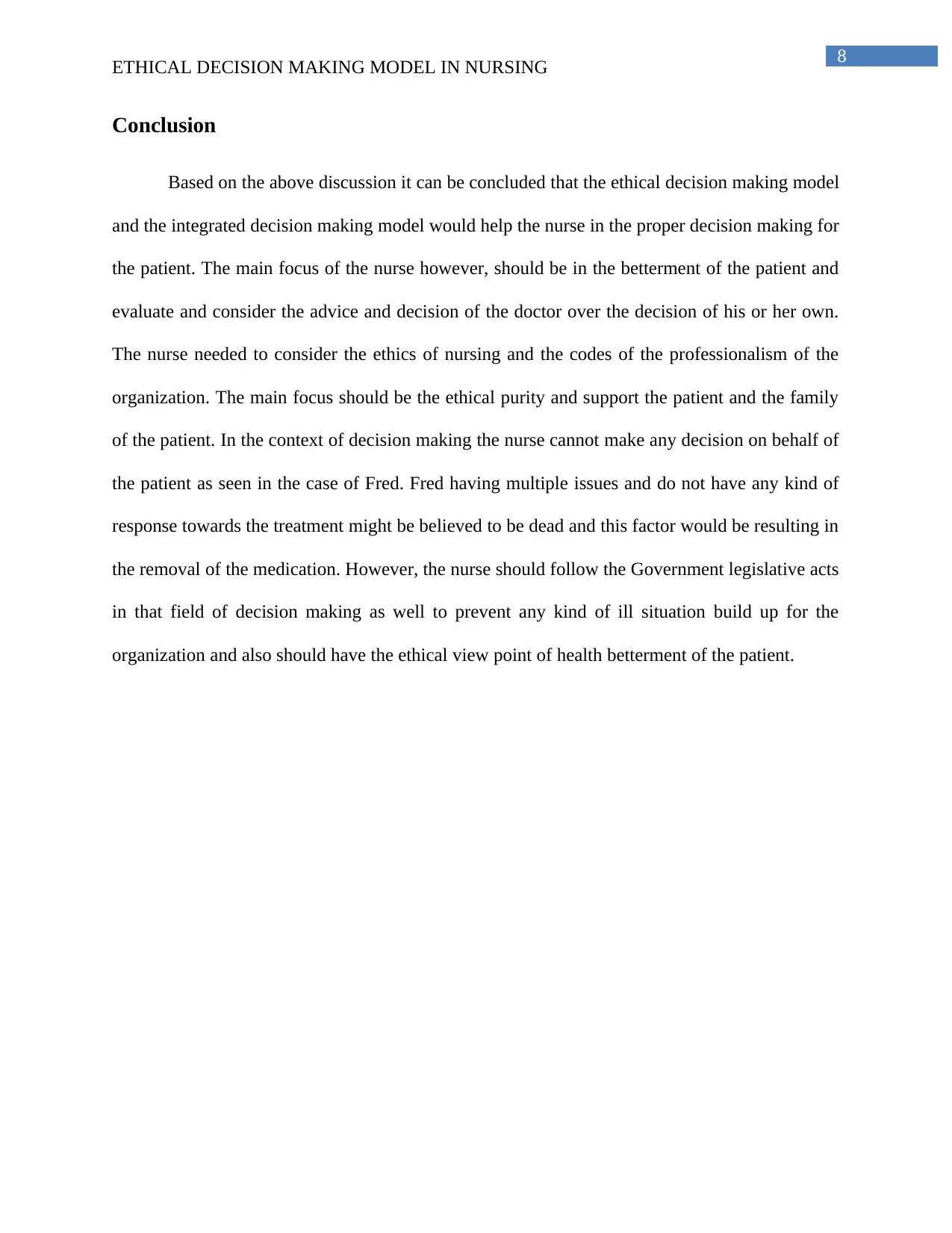
8
ETHICAL DECISION MAKING MODEL IN NURSING
Conclusion
Based on the above discussion it can be concluded that the ethical decision making model
and the integrated decision making model would help the nurse in the proper decision making for
the patient. The main focus of the nurse however, should be in the betterment of the patient and
evaluate and consider the advice and decision of the doctor over the decision of his or her own.
The nurse needed to consider the ethics of nursing and the codes of the professionalism of the
organization. The main focus should be the ethical purity and support the patient and the family
of the patient. In the context of decision making the nurse cannot make any decision on behalf of
the patient as seen in the case of Fred. Fred having multiple issues and do not have any kind of
response towards the treatment might be believed to be dead and this factor would be resulting in
the removal of the medication. However, the nurse should follow the Government legislative acts
in that field of decision making as well to prevent any kind of ill situation build up for the
organization and also should have the ethical view point of health betterment of the patient.
ETHICAL DECISION MAKING MODEL IN NURSING
Conclusion
Based on the above discussion it can be concluded that the ethical decision making model
and the integrated decision making model would help the nurse in the proper decision making for
the patient. The main focus of the nurse however, should be in the betterment of the patient and
evaluate and consider the advice and decision of the doctor over the decision of his or her own.
The nurse needed to consider the ethics of nursing and the codes of the professionalism of the
organization. The main focus should be the ethical purity and support the patient and the family
of the patient. In the context of decision making the nurse cannot make any decision on behalf of
the patient as seen in the case of Fred. Fred having multiple issues and do not have any kind of
response towards the treatment might be believed to be dead and this factor would be resulting in
the removal of the medication. However, the nurse should follow the Government legislative acts
in that field of decision making as well to prevent any kind of ill situation build up for the
organization and also should have the ethical view point of health betterment of the patient.
⊘ This is a preview!⊘
Do you want full access?
Subscribe today to unlock all pages.

Trusted by 1+ million students worldwide
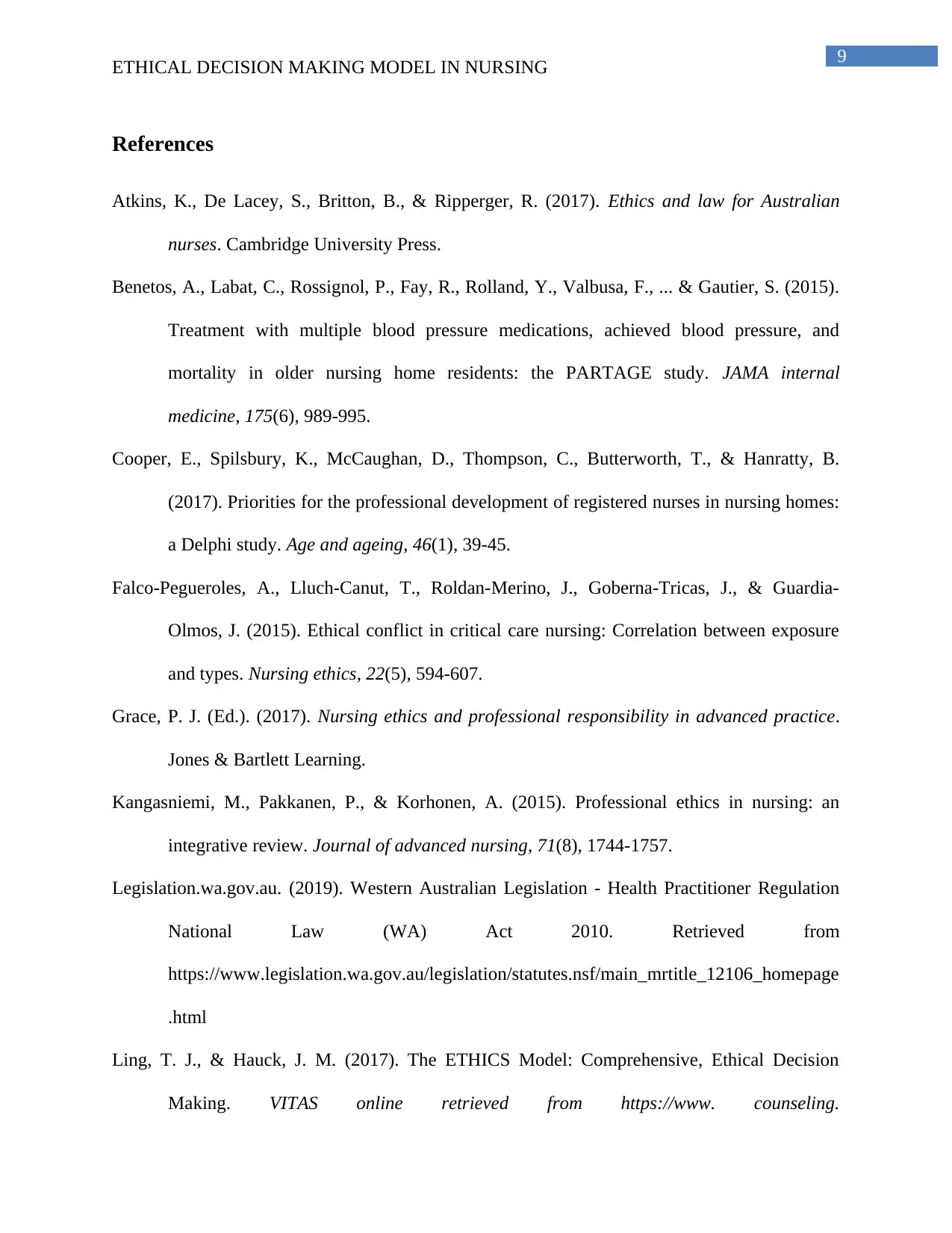
9
ETHICAL DECISION MAKING MODEL IN NURSING
References
Atkins, K., De Lacey, S., Britton, B., & Ripperger, R. (2017). Ethics and law for Australian
nurses. Cambridge University Press.
Benetos, A., Labat, C., Rossignol, P., Fay, R., Rolland, Y., Valbusa, F., ... & Gautier, S. (2015).
Treatment with multiple blood pressure medications, achieved blood pressure, and
mortality in older nursing home residents: the PARTAGE study. JAMA internal
medicine, 175(6), 989-995.
Cooper, E., Spilsbury, K., McCaughan, D., Thompson, C., Butterworth, T., & Hanratty, B.
(2017). Priorities for the professional development of registered nurses in nursing homes:
a Delphi study. Age and ageing, 46(1), 39-45.
Falco-Pegueroles, A., Lluch-Canut, T., Roldan-Merino, J., Goberna-Tricas, J., & Guardia-
Olmos, J. (2015). Ethical conflict in critical care nursing: Correlation between exposure
and types. Nursing ethics, 22(5), 594-607.
Grace, P. J. (Ed.). (2017). Nursing ethics and professional responsibility in advanced practice.
Jones & Bartlett Learning.
Kangasniemi, M., Pakkanen, P., & Korhonen, A. (2015). Professional ethics in nursing: an
integrative review. Journal of advanced nursing, 71(8), 1744-1757.
Legislation.wa.gov.au. (2019). Western Australian Legislation - Health Practitioner Regulation
National Law (WA) Act 2010. Retrieved from
https://www.legislation.wa.gov.au/legislation/statutes.nsf/main_mrtitle_12106_homepage
.html
Ling, T. J., & Hauck, J. M. (2017). The ETHICS Model: Comprehensive, Ethical Decision
Making. VITAS online retrieved from https://www. counseling.
ETHICAL DECISION MAKING MODEL IN NURSING
References
Atkins, K., De Lacey, S., Britton, B., & Ripperger, R. (2017). Ethics and law for Australian
nurses. Cambridge University Press.
Benetos, A., Labat, C., Rossignol, P., Fay, R., Rolland, Y., Valbusa, F., ... & Gautier, S. (2015).
Treatment with multiple blood pressure medications, achieved blood pressure, and
mortality in older nursing home residents: the PARTAGE study. JAMA internal
medicine, 175(6), 989-995.
Cooper, E., Spilsbury, K., McCaughan, D., Thompson, C., Butterworth, T., & Hanratty, B.
(2017). Priorities for the professional development of registered nurses in nursing homes:
a Delphi study. Age and ageing, 46(1), 39-45.
Falco-Pegueroles, A., Lluch-Canut, T., Roldan-Merino, J., Goberna-Tricas, J., & Guardia-
Olmos, J. (2015). Ethical conflict in critical care nursing: Correlation between exposure
and types. Nursing ethics, 22(5), 594-607.
Grace, P. J. (Ed.). (2017). Nursing ethics and professional responsibility in advanced practice.
Jones & Bartlett Learning.
Kangasniemi, M., Pakkanen, P., & Korhonen, A. (2015). Professional ethics in nursing: an
integrative review. Journal of advanced nursing, 71(8), 1744-1757.
Legislation.wa.gov.au. (2019). Western Australian Legislation - Health Practitioner Regulation
National Law (WA) Act 2010. Retrieved from
https://www.legislation.wa.gov.au/legislation/statutes.nsf/main_mrtitle_12106_homepage
.html
Ling, T. J., & Hauck, J. M. (2017). The ETHICS Model: Comprehensive, Ethical Decision
Making. VITAS online retrieved from https://www. counseling.
Paraphrase This Document
Need a fresh take? Get an instant paraphrase of this document with our AI Paraphraser
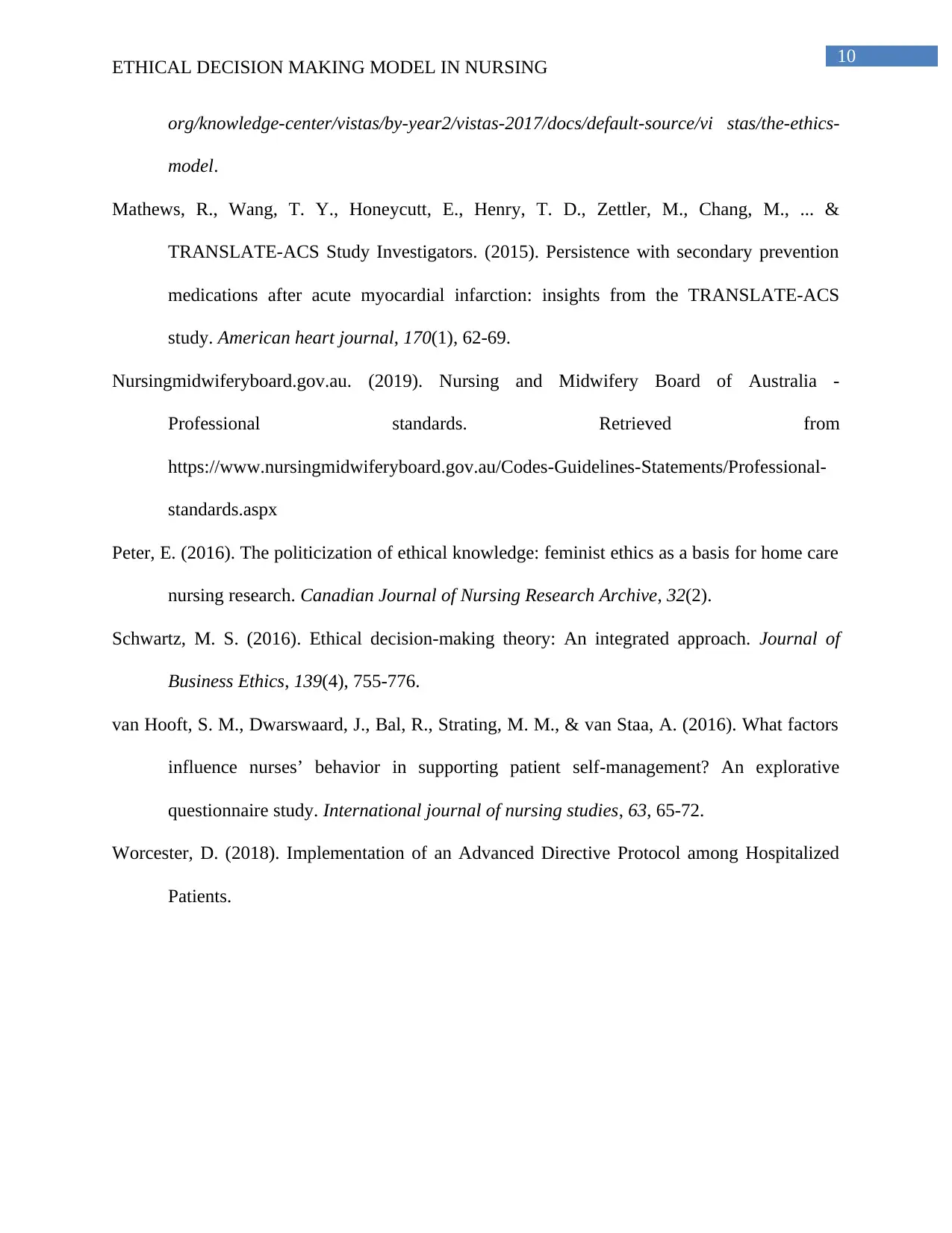
10
ETHICAL DECISION MAKING MODEL IN NURSING
org/knowledge-center/vistas/by-year2/vistas-2017/docs/default-source/vi stas/the-ethics-
model.
Mathews, R., Wang, T. Y., Honeycutt, E., Henry, T. D., Zettler, M., Chang, M., ... &
TRANSLATE-ACS Study Investigators. (2015). Persistence with secondary prevention
medications after acute myocardial infarction: insights from the TRANSLATE-ACS
study. American heart journal, 170(1), 62-69.
Nursingmidwiferyboard.gov.au. (2019). Nursing and Midwifery Board of Australia -
Professional standards. Retrieved from
https://www.nursingmidwiferyboard.gov.au/Codes-Guidelines-Statements/Professional-
standards.aspx
Peter, E. (2016). The politicization of ethical knowledge: feminist ethics as a basis for home care
nursing research. Canadian Journal of Nursing Research Archive, 32(2).
Schwartz, M. S. (2016). Ethical decision-making theory: An integrated approach. Journal of
Business Ethics, 139(4), 755-776.
van Hooft, S. M., Dwarswaard, J., Bal, R., Strating, M. M., & van Staa, A. (2016). What factors
influence nurses’ behavior in supporting patient self-management? An explorative
questionnaire study. International journal of nursing studies, 63, 65-72.
Worcester, D. (2018). Implementation of an Advanced Directive Protocol among Hospitalized
Patients.
ETHICAL DECISION MAKING MODEL IN NURSING
org/knowledge-center/vistas/by-year2/vistas-2017/docs/default-source/vi stas/the-ethics-
model.
Mathews, R., Wang, T. Y., Honeycutt, E., Henry, T. D., Zettler, M., Chang, M., ... &
TRANSLATE-ACS Study Investigators. (2015). Persistence with secondary prevention
medications after acute myocardial infarction: insights from the TRANSLATE-ACS
study. American heart journal, 170(1), 62-69.
Nursingmidwiferyboard.gov.au. (2019). Nursing and Midwifery Board of Australia -
Professional standards. Retrieved from
https://www.nursingmidwiferyboard.gov.au/Codes-Guidelines-Statements/Professional-
standards.aspx
Peter, E. (2016). The politicization of ethical knowledge: feminist ethics as a basis for home care
nursing research. Canadian Journal of Nursing Research Archive, 32(2).
Schwartz, M. S. (2016). Ethical decision-making theory: An integrated approach. Journal of
Business Ethics, 139(4), 755-776.
van Hooft, S. M., Dwarswaard, J., Bal, R., Strating, M. M., & van Staa, A. (2016). What factors
influence nurses’ behavior in supporting patient self-management? An explorative
questionnaire study. International journal of nursing studies, 63, 65-72.
Worcester, D. (2018). Implementation of an Advanced Directive Protocol among Hospitalized
Patients.
1 out of 11
Related Documents
Your All-in-One AI-Powered Toolkit for Academic Success.
+13062052269
info@desklib.com
Available 24*7 on WhatsApp / Email
![[object Object]](/_next/static/media/star-bottom.7253800d.svg)
Unlock your academic potential
Copyright © 2020–2025 A2Z Services. All Rights Reserved. Developed and managed by ZUCOL.





